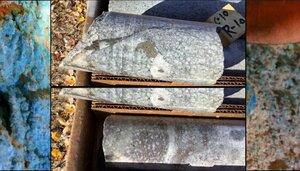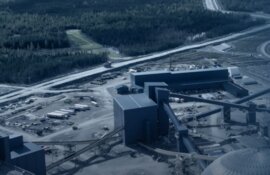Thanks to surging gold prices over the past two years, major producers have achieved record profits, expanded their margins, and generated exceptional cash flow, as John Zadeh, Discovery Alert's founder and chief executive officer (CEO), wrote in an Aug. 30 article. An improved financial situation allowed them to pursue strategic goals, such as reducing debt, boosting shareholder returns, conducting mergers and acquisitions activity, and, for some miners, expanding the copper component of their business. Despite these benefits, many face continuing cost headwinds, however.
"Costs have also escalated with higher energy, labor, and material inputs," reported William Clowes, Bloomberg's Africa mining and metals correspondent, on Aug. 28.
In Q1/25, these and other persisting factors led to higher costs for large gold miners, reported Zadeh on June 13 after compiling and analyzing 18 such companies' data. As for utilities, for instance, diesel fuel costs increased about 15% globally, inflating the price to haul goods. In Australia, water management requirements drove up costs at several mines, and natural gas prices rose 22%. In terms of labor, for example, U.S. mining wages increased 8.1% YOY. In Australia, shortages of skilled workers resulted in a 12% wage premium for experienced operators.
Operational challenges, such as lower grades and declining production, contributed to higher costs. Compliance with new environmental and other regulations did, too. For instance, new environmental regulations in Canada padded costs by about US$15–20 per ounce (US$15–20/oz) at numerous operations. Worldwide, expenses tied to carbon emissions reporting and remediation rose.
Here is a look at three gold majors that have benefitted greatly from climbing gold prices but remain laser focused on cost reduction. All the while, they continue striving to achieve the highest performance possible financially and operationally to create value for and return cash to shareholder.
Harmony Gold
Based in South Africa, Harmony Gold Mining Co. Ltd. (HMY:NYSE; HAR:JSE) is a miner involved in gold exploration, extraction, and processing at about 10 projects, in South Africa and Papua New Guinea.
 Streetwise Ownership Overview*
Streetwise Ownership Overview*
Harmony Gold Mining Co. Ltd. (HMY:NYSE; HAR:JSE)
Due in large part to rising gold prices, the largest gold producer in South Africa gained 65% so far in 2025 as of Aug. 28, according to Clowes. In the last fiscal year (FY25), the company saw about a 66% profit increase to R14.4 billion (R14.4B). The average price it received on gold sales increased by 27% to US$2,620 an ounce (US$2,620/oz) during the period. The company's Q4 FY25 financial results stood out for two reasons. One was the highest ever free cash flow of R11 billion-plus at a 16% margin, the other was the greatest ever final dividend, of R2.4B, Mining Weekly reported on Aug. 28.
Harmony expects its total costs to expand to 16% from 9% during FY26 (started July 1) due to inflation and its plans to update some of its mines, Clowes wrote. This is after a 17% cost uptick in FY25. As for capex, for instance, over the next 10 months, the miner estimates a nearly R2B increase to R13B to extend the lives of its flagship operations in South Africa and replace essential machinery at one of its projects in Papua New Guinea.
Gold producers operating in South Africa are facing declining production due to deeper mines and worsening labor and utility costs, wrote Sabrina Jardim in a June 7 Mining Weekly article. This was the case for Harmony, whose gold production dropped 5% during FY25, noted Clowes.
During Q3 FY25, the producer's all-in sustaining cost was 23.96% higher year over year (YOY, Discovery Alert's Zadeh reported. Three contributors were a 17% YOY depreciation of the rand and higher power tariffs imposed by state-owned utility Eskom, both in South Africa, and increased stripping ratios at Harmony's operations.
The gold company is boosting the copper component of its business with three projects in Australia, to capitalize on the green energy transition, to which copper is critical, and to diversify. Management aims to take its production of the red metal to about 40% by 2035, reported Clowes. Further, it intends to decide soon on whether to develop its 100%-owned Eva iron-oxide copper-gold project it purchased in 2022. In October, it expects to close its US$1.03B acquisition of MAC Copper Ltd., owner of the low-cost, producing CSA mine. As for Wafi-Golpu, 50/50 joint venture (JV) partners Harmony Gold and Newmont Mining Corp. are advancing the project, boasting an estimated copper resource of 4,400,000 tons and now in the permitting phase, reported Zadeh in an Aug. 31 Discovery Alert article.
"Mining sector specialists note that Wafi-Golpu's development would transform Harmony from a mid-tier gold producer with copper exposure to a major diversified metals company with significant production of both gold and copper," Zadeh added.
Nedbank Analyst Arnold van Graan has a Neutral rating on Harmony Gold and a target price implying 28% return from its stock price at the close on Aug. 29, reports Refinitiv. The consensus target suggests a 9% uplift.
Also according to Refinitiv, eight strategic entities own 11.91% of Harmony Gold, 225 institutions have 54.88% and retail investors hold the remainder.
The Top 3 shareholders overall are Public Investment Corp. (SOC) Ltd. with 14.67%, African Rainbow Minerals Ltd. with 11.76% and Van Eck Associates Corp. with 9.99%.
Harmony has 622.18 million shares outstanding. Its market cap is US$8.4B.
Newmont Corp.
Headquartered in Denver, Colo., Newmont Corp. (NEM:NYSE; NGT:TSX; NEM:ASX) is the world's largest gold producer with many wholly and joint venture-owned operations in North America, South America, Australia, and Africa.
 Streetwise Ownership Overview*
Streetwise Ownership Overview*
Newmont Corp. (NEM:NYSE;NGT:TSX;NEM:ASX)
The miner's 2025 so far has been robust, reported Investing.com on Aug. 29. Year to date, the miner's share price gained 98.14% and reached a 52-week high of US$73.40. Q2/25 earnings were strong, with Newmont generating an all-time record quarterly free cash flow of US$1.7B and reducing its debt by US$372 million (US$372M), according to a news release.
Over the past five years, however, Newmont's all-in sustaining cost (AISC) jumped more than 50%, fueled by higher energy, labor and material costs, reported AInvest in an Aug. 28 article. Costs ran up since the major acquired Newcrest Mining and its 20 mines in 2023 for US$15B. Some of these acquired assets in particular, such as the Lihir mine in Papua New Guinea and the Cadia operation in Australia, struggled with rising expenses.
Earlier this year, Newmont's AISC per ounce gold reached a record high. In H1/25, it was US$1,623/oz gold, up from US$1,500/oz a year earlier, according to the company. Lower production was a factor, Zadeh pointed out. For instance, Q1/25 production was down 8.51% YOY, partly because of 12% lower grades at the miner's Peñasquito mine in Mexico. At the end of H1/25, management maintained 2025 cost guidance of US$1,620/oz gold but indicated it expects further inflationary pressure in H2/25, AInvest wrote.
Through a major cost-lowering and productivity improvement initiative launched in February, Newmont aims to reduce costs by 20% or up to about US$300/oz, to achieve costs in line with its low-cost peers, noted VBL on Aug. 28. For advice on the endeavor, the major engaged Boston Consulting Group. One cost-cutting measure will be to reduce headcount. To this end, around Oct. 28, Newmont will begin eliminating 19 positions in all, most of them managerial, at its Denver headquarters and at its technical facility in Englewood, also in Colorado, it was reported in The Denver Post on Aug. 29.
Also, Newmont has been eliminating the noncore assets in its portfolio to focus mostly on its tier one projects to strengthen its financial position and return more capital to shareholders. This year, it divested Telfer in Australia, Akyem in Ghana, Cripple Creek & Victor in the U.S. and Porcupine, Musselwhite and Éléonore in Canada. Further, it sold its equity stakes in Greatland Resources and Discovery Silver.
One of Newmont's key reasons behind acquiring Newcrest was to increase its exposure to copper. Gaining the copper-gold projects, Red Chris, British Columbia, Cadia in Australia, and Wafi-Golpu in Papua New Guinea (JV with Harmony Gold), boosted its copper reserves by almost 14,400,000,000 pounds, according to Newmont. Its copper output in Q2/25 was 36,000 tons, to which its Boddington gold-copper project in Australia contributed, noted a news release. Newmont's integration of these Newcrest copper assets continues.
Investor Eliana Scialabba, in an Aug. 27 Seeking Alpha article, reiterated her Buy recommendation on Newmont. She wrote that it "remains a cash flow machine with an increasing copper leverage, although the market continues to underestimate its long-term strategic positioning." Its multiples are attractive and its profitability ranks it among the industry's leaders.
Shane Nagle, analyst with National Bank Financial, has an Outperform rating on Newmont and a target price implying 8% upside from its Aug. 29 closing price, Refinitiv reports.
Also, Refinitiv indicates that Newmont's ownership breaks down this way: 31 strategic investors own 0.27%, 1,936 institutional investors have 80.03% and retail investors hold the rest. The mining major's Top 3 shareholders are The Vanguard Group Inc. with 12.24%, BlackRock Institutional Trust Co. N.A. with 5.3% and State Street Global Advisors (U.S.) with 4.52%. Newmont has 1 billion shares outstanding and a market cap of US$81.7B. Its 52-week range is US$36.86–73.29 per share.
Barrick Mining
Headquartered in Toronto, Ontario, Barrick Mining Corp. (ABX:TSX; B:NYSE) is the world's No. 3 largest gold producer and is a copper producer as well, with assets in 18 countries in North America, South America, Africa, Asia and Oceania. Year to date the company's stock is up 71.41%, and it reached a 52-week high of US$26.80, reported Investing.com on Aug. 29.
 Streetwise Ownership Overview*
Streetwise Ownership Overview*
Barrick Mining Corp. (ABX:TSX; B:NYSE)
As for Q2/25 earnings, the miner's performance beat expectations on stronger gold and copper production, reported Neils Christensen for Kitco News on Aug. 11. Revenue was US$3.68B, just under US$3.73B consensus. Free cash flow in H1/25 was US$770M, up 107% YOY.
However, YOY in Q2/25, cash costs per ounce gold were up 17%, contributing to the 12% rise in AISC to US$1,684/oz, according to an Aug. 14 Yahoo Finance article. Lower YOY production, partly due to the suspension of operations at Loulo-Gounkoto in Mali, also contributed to cost increases. Similarly, YOY in Q1/25, Barrick's AISC rose 20.42%, and production fell 19.36%, driven in part by lower grades at Pueblo Viejo in the Dominican Republic, Zadeh wrote.
"This case illustrates how fixed costs like administration, infrastructure maintenance, and certain labor expenses remain relatively constant regardless of production volume, creating significant leverage effect on per-ounce costs," Zadeh explained.
As for copper, Barrick intends to shore up its production such that it accounts for 40% of its EBITDA by 2030; in 2023 its portion was 15%, Zadeh reported in an April 7 Discovery Alert article. Success in this regard requires the successful execution of the Reko Diq project in Pakistan and the Lumwana project in Zambia within cost and time budgets. With its strong balance, the major is likely to acquire copper projects, similar to how it did in the gold space. The miner now goes by Barrick Mining Corp. rather than Barrick Gold Corp.
"The name change reflects our evolution into a modern, diversified miner," Barrick Chief Executive Officer Mark Bristow told Discovery Alert. "Copper is critical for renewable energy, and we're positioning Barrick to lead this transition."
CIBC Analyst Anita Soni wrote in an Aug. 11 research report that she upgraded her rating on Barrick to Outperformer from Neutral and increased her target price by US$2 per share after incorporating Q2/25 results into her company model. Her new target implies a 13% return from Barrick's share price at closing on Aug. 29.
"Turning the page on the challenging 2022-2024 period, with Q1/25 and Q2/25 results, Barrick has delivered against expectations and is on track to achieve production guidance," Soni wrote. "With this recent operational consistency, we are more comfortable that go-forward estimates can be relied upon, and the stock is indeed undervalued relative to peers."
Going forward, Soni wrote, Barrick is expected to lower costs, focus on core assets, maximize free cash flow, drive return on investment capital, maintain a strong balance sheet and provide returns to shareholders.
According to Refinitiv, institutional investors own the greatest interest in Barrick, 63.03%. Strategic investors own 0.9%. The remainder is retail. The Top 3 shareholders overall are Capital International Investors with 4.39%, Wellington Management Co. LLP with 4.29% and The Vanguard Group Inc. with 4.06%. Barrick has 1.7 billion outstanding shares. Its market cap is CA$45.5B. Its 52-week range is CA$21.73 to 37.07 per share.
Gold Prices Expected to Climb Higher
It is just a matter of time before gold prices hit new all-time highs, Chantelle Schieven, head of research at Capitalight Research, told Kitco News on Aug. 29. At the end of August, the spot gold price was US$3,443/oz, a record high for the summer month during which it typically is in the doldrums, Neils Christensen reported.
Newsletter Writer Stewart Thomson wrote in an Aug. 29 note that the chance now of gold breaking out is 90% compared to 70% a couple of weeks ago. On its weekly chart, gold appears to be breaking out of a substantial symmetrical triangle pattern, and the 14,5,5 series Stochastics oscillator action looks "incredibly bullish."
The NYSE Arca Gold BUGS Index (HUI), a modified equal dollar weighted index of companies involved in gold mining, rose about 20% in August, its best August ever, Robert Sinn with Goldfinger Capital pointed out in an Aug. 29 post. This indicates that it is early days in the current bull cycle. Also, Sinn wrote, the 14-day Relative Strength Index indicator for the HUI last moved past 80 in summer 2003. Subsequently, it rose another roughly 200% before hitting its peak of the cycle in March 2008.
According to Brien Lundin of Gold Newsletter on Aug. 28, the stage is set for upward momentum in the gold price. All that is needed is a catalyst, potentially a U.S. Federal Reserve rate cut on Sept. 17. He pointed out that gold could be hit hard if U.S. President Trump retreats from his peace-for-Ukraine play, but it should not last long. Were Trump to facilitate a peace deal for Ukraine, central banks likely would weight their reserves more toward gold and away from the U.S. dollar.
"All of this is pointing toward a new rally in gold, one that should take it finally above US$3,500 and into open sky thereafter," Lundin added.
As for gold price estimates, the Bank of America boosted its long-term target 25% to US$2,500/oz on the expectation of continued structural weakness in the U.S. economy, reported Fiona Craig for MSN.com on Aug. 30. This encompasses ongoing fiscal deficits, inflationary pressures from deglobalization, questions about the Fed's independence, and rising geopolitical tensions. The bank's analysts took their six-year average gold price prediction 6% higher to US$3,049/oz and reiterated their US$4,000/oz short- and medium-term upside target. They still expect US$3,356/oz gold this year and US$3,659/oz next year.
Outside of Bank of America, many analysts in general expect the gold price to advance materially next year, fueled by expectations of a Fed rate cut and rising inflation, reported Mario Lagos for deVere in an Aug. 28 article. Some even think that reaching US$4,000/oz is feasible. For instance, UBS now expects US$3,700 gold by the start of October 2026 due to sticky inflation, tariff impacts, and migration curbs. J.P. Morgan now says gold could average US$3,675 in Q4/25 then head toward US$4,000 in Q2/26 due to record demand from central banks and individual investors, along with ongoing inflation and trade risks.
Natasha Kaneva, head of Global Commodities Strategy, told Lagos: "We remain deeply convinced of a continued structural bull case for gold and raise our price targets accordingly."
Gold price support also should come from exchange-traded fund flows, a weaker U.S. dollar, and geopolitical uncertainty.
"Consensus estimates suggest gold will average in the mid-US$3,000s for the rest of 2025, with a plausible upside path toward US$4,000 in 2026," Lagos wrote. "The outlook remains conditional, however; a stronger U.S. dollar or higher real rates could cap gains."
| Want to be the first to know about interesting Copper and Gold investment ideas? Sign up to receive the FREE Streetwise Reports' newsletter. | Subscribe |
Important Disclosures:
- As of the date of this article, officers and/or employees of Streetwise Reports LLC (including members of their household) own securities of Barrick Mining Corp.
- Doresa Banning wrote this article for Streetwise Reports LLC and provides services to Streetwise Reports as an independent contractor.
- This article does not constitute investment advice and is not a solicitation for any investment. Streetwise Reports does not render general or specific investment advice and the information on Streetwise Reports should not be considered a recommendation to buy or sell any security. Each reader is encouraged to consult with his or her personal financial adviser and perform their own comprehensive investment research. By opening this page, each reader accepts and agrees to Streetwise Reports' terms of use and full legal disclaimer. Streetwise Reports does not endorse or recommend the business, products, services or securities of any company.
For additional disclosures, please click here.









































